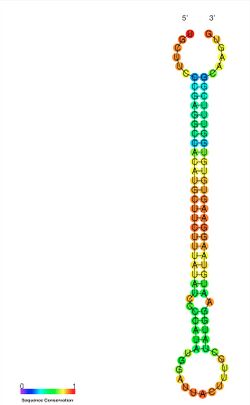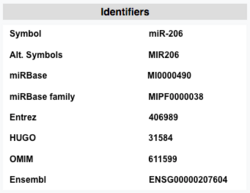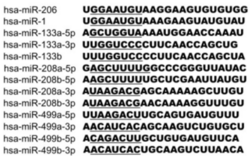Biology:MiR-206
MiR-206 is a microRNA with a sequence conserved across most mammalian species, and in humans is a member of the myo-miR family of miRNAs, which includes miR-1, miR-133, and miR-208a/b.[1][2][3][4] Mir-206 is well established for the regulation of cellular processes involving skeletal muscle development, as well as mitochondrial functioning. miR-206 is studied in C2C12 myoblast cells as this is a widely used model for the study of cellular differentiation of skeletal muscle.[5] The biogenesis of miR-206 is unique in that the primary mature transcript is generated from the 3p arm of the precursor microRNA hairpin rather than the 5p arm.[6] Currently, miR-206 has approximately twelve miRNA family members (six of which are shown in Table 1), and the cognate seed sequence (nucleotides 2-8) of the miR-206 family is conserved across all twelve miRNA members.
While miR-206 is tightly regulated during the embryonic development of skeletal muscle, miR-206 is also regulated by the nuclear steroid hormone receptor 17β-estradiol.[7][8] Further evidence supporting the role of miR-206 in tumorigenesis originates from studies showing miR-206 is highly expressed in triple-negative breast tumors that grow independent of 17β-estradiol when compared to estrogen-receptor positive (ERα+), 17β-estradiol sensitive breast cancer cells. miR-206 is also an indicator of poorer overall survival rates in breast cancer patients.[9] While miR-206 has a well defined role in breast tumor etiology, miR-206 was recently shown to control mesothelioma progression via the regulation of the Ras signaling pathway[10] These studies add to an increasing body of literature showing how small noncoding regulatory RNAs maintain the normal cellular processes that prevent the tumorigenic process. A number of cell lines used to elucidate the role of miR-206 in breast cancer include MCF-7, MDA-MB-231, and MDA-MB-468 cell lines.
Single nucleotide polymorphisms (SNPs) can be located in the miRNA seed sequence, and therefore are known to have functional consequences. One such effect is the altered binding efficacy of a miRNA to the cognate mRNA target based on the altered single nucleotide composition of the miRNA seed region.[11] In fact, a number of studies have indicated that the canonical seed sequence of a miRNA is not a sole determinate in miRNA:mRNA pairing interactions, as mutations of residues outside the seed region can also alter this binding efficacy. The miR-206 regulation of ERα through the direct binding of miR-206 in the ERα 3' UTR,[7] is a good example of how a miRNA:mRNA base pairing interaction can be influenced by SNPs.
A number of additional miR-206 regulatory modules have been identified, such as the lncRNA HOTAIR mediated up-regulation of Bcl-w through sequestration of miR-206 which in turn enhances cellular proliferation in breast cancer cells.[12] This study indicates miR-206 can interact with other non-coding RNAs to control a variety of tumorigenic process in a number of cancer systems. In support of this, SNHG14 can also sponge miR-206 thereby modulating the abundance of YWHAZ in cervical cancer.[13] Together, these studies and the numerous studies not cited here due to space limitations, clearly show the therapeutic potential of a miRNA such as miR-206 in the oncological setting.
Outside the realm of tumor biology, miR-206 is of clinical interest due to the continued detection of this miRNA in samples from those with type 2 diabetes (TIID) and non-alcoholic fatty liver disease (NAFLD). In some studies the therapeutic delivery of miR-206 in a dietary obese mouse model resulted in reduced lipid and glucose production within the liver. The ability of miR-206 to facilitate insulin signaling and modulate lipogenesis indicates miR-206 may be a novel therapy for those with hyperglycemia.[14] Mir-206 has also recently been identified as a biomarker for certain limb dystrophies,[15] while circulating miR-206 levels are associative with preeclampsia.[16]
References
- ↑ "Expression profiling of mammalian microRNAs uncovers a subset of brain-expressed microRNAs with possible roles in murine and human neuronal differentiation". Genome Biology 5 (3): R13. 2004. doi:10.1186/gb-2004-5-3-r13. PMID 15003116.
- ↑ "A family of microRNAs encoded by myosin genes governs myosin expression and muscle performance". Developmental Cell 17 (5): 662–73. November 2009. doi:10.1016/j.devcel.2009.10.013. PMID 19922871.
- ↑ "Regulation of PI3-kinase/Akt signaling by muscle-enriched microRNA-486". Proceedings of the National Academy of Sciences of the United States of America 107 (9): 4218–23. March 2010. doi:10.1073/pnas.1000300107. PMID 20142475. Bibcode: 2010PNAS..107.4218S.
- ↑ "Control of stress-dependent cardiac growth and gene expression by a microRNA". Science 316 (5824): 575–9. April 2007. doi:10.1126/science.1139089. PMID 17379774. Bibcode: 2007Sci...316..575V.
- ↑ Yaffe, D.; Saxel, O. (Dec 22–29, 1977). "Serial passaging and differentiation of myogenic cells isolated from dystrophic mouse muscle". Nature 270 (5639): 725–727. doi:10.1038/270725a0. ISSN 0028-0836. PMID 563524. Bibcode: 1977Natur.270..725Y. https://pubmed.ncbi.nlm.nih.gov/563524/.
- ↑ "miRBase: annotating high confidence microRNAs using deep sequencing data". Nucleic Acids Research 42 (Database issue): D68–73. January 2014. doi:10.1093/nar/gkt1181. PMID 24275495.
- ↑ 7.0 7.1 "The micro-ribonucleic acid (miRNA) miR-206 targets the human estrogen receptor-alpha (ERalpha) and represses ERalpha messenger RNA and protein expression in breast cancer cell lines". Molecular Endocrinology 21 (5): 1132–47. May 2007. doi:10.1210/me.2007-0022. PMID 17312270.
- ↑ "The role of miR-206 in the epidermal growth factor (EGF) induced repression of estrogen receptor-alpha (ERalpha) signaling and a luminal phenotype in MCF-7 breast cancer cells". Molecular Endocrinology 23 (8): 1215–30. August 2009. doi:10.1210/me.2009-0062. PMID 19423651.
- ↑ "miR-206 Expression is down-regulated in estrogen receptor alpha-positive human breast cancer". Cancer Research 68 (13): 5004–8. July 2008. doi:10.1158/0008-5472.CAN-08-0180. PMID 18593897.
- ↑ Singh, Anand; Pruett, Nathanael; Pahwa, Roma; Mahajan, Arushi P.; Schrump, David S.; Hoang, Chuong D. (2021-06-04). "MicroRNA-206 suppresses mesothelioma progression via the Ras signaling axis" (in English). Molecular Therapy: Nucleic Acids 24: 669–681. doi:10.1016/j.omtn.2021.04.001. ISSN 2162-2531. PMID 33996251.
- ↑ "MicroRNA targeting specificity in mammals: determinants beyond seed pairing". Molecular Cell 27 (1): 91–105. July 2007. doi:10.1016/j.molcel.2007.06.017. PMID 17612493.
- ↑ Ding, Wei; Ren, Jin; Ren, Hui; Wang, Dan (2017-12-08). "Long Noncoding RNA HOTAIR Modulates MiR-206-mediated Bcl-w Signaling to Facilitate Cell Proliferation in Breast Cancer" (in en). Scientific Reports 7 (1): 17261. doi:10.1038/s41598-017-17492-x. ISSN 2045-2322. PMID 29222472. Bibcode: 2017NatSR...717261D.
- ↑ Ji, Nannan; Wang, Yuhuan; Bao, Guangli; Yan, Juanli; Ji, Sha (2019-04-01). "LncRNA SNHG14 promotes the progression of cervical cancer by regulating miR-206/YWHAZ" (in en). Pathology - Research and Practice 215 (4): 668–675. doi:10.1016/j.prp.2018.12.026. ISSN 0344-0338. PMID 30611620. https://www.sciencedirect.com/science/article/pii/S0344033818314328.
- ↑ "MicroRNA-206 prevents hepatosteatosis and hyperglycemia by facilitating insulin signaling and impairing lipogenesis". Journal of Hepatology 66 (4): 816–824. April 2017. doi:10.1016/j.jhep.2016.12.016. PMID 28025059.
- ↑ Pegoraro, Valentina; Angelini, Corrado (2021-01-12). "Circulating miR-206 as a Biomarker for Patients Affected by Severe Limb Girdle Muscle Dystrophies". Genes 12 (1): 85. doi:10.3390/genes12010085. ISSN 2073-4425. PMID 33445560.
- ↑ Schlosser, Kenny; Kaur, Amanpreet; Dayan, Natalie; Stewart, Duncan J.; Pilote, Louise; Delles, Christian (2020-01-31). "Circulating miR-206 and Wnt-signaling are associated with cardiovascular complications and a history of preeclampsia in women". Clinical Science 134 (2): 87–101. doi:10.1042/CS20190920. ISSN 1470-8736. PMID 31899480.
 |




